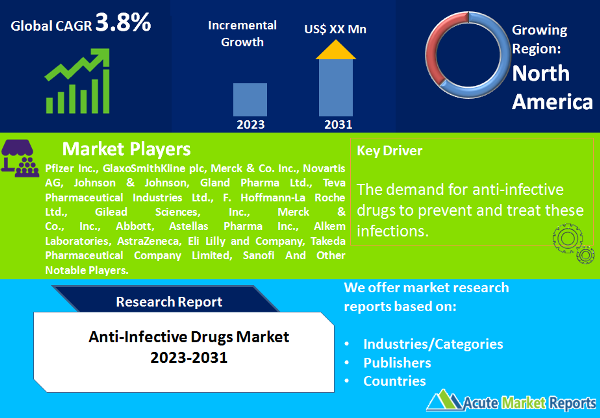
The anti-infective drugs market is expected to witness a CAGR of 3.8% during the forecast period of 2025 to 2033, driven by various factors. Anti-infective drugs, also known as antimicrobial drugs, are used to treat infectious diseases caused by bacteria, viruses, fungi, and parasites. These drugs play a crucial role in combating infections and reducing morbidity and mortality rates associated with infectious diseases. This analysis provides a brief overview of the anti-infective drugs market, followed by an in-depth examination of the three key drivers and one restraint impacting the market. Furthermore, the market is segmented based on drug class and route of administration, along with an exploration of geographic trends and the competitive landscape.

Increasing Prevalence of Infectious Diseases
The rising prevalence of infectious diseases is a major driver contributing to the growth of the anti-infective drugs market. In recent years, the world has witnessed outbreaks of infectious diseases, which have highlighted the importance of effective anti-infective drugs. Infectious diseases continue to pose significant global health challenges, affecting millions of people and driving the demand for anti-infective drugs to combat various infections, including respiratory infections, sexually transmitted diseases, and gastrointestinal infections. The increasing prevalence of healthcare-associated infections has also driven the demand for anti-infective drugs to prevent and treat these infections. This driver is further supported by data from the World Health Organization (WHO), which states that lower respiratory infections, including pneumonia, were the third leading cause of global mortality in 2020, causing over 2.5 million deaths.
Emergence of Antimicrobial Resistance
Antimicrobial resistance (AMR) is a pressing public health concern that has fueled the demand for innovative and effective anti-infective drugs. Overuse and misuse of antimicrobial drugs have led to the development of drug-resistant pathogens, making traditional antibiotics less effective. This has necessitated the development of new anti-infective drugs with novel mechanisms of action to combat drug-resistant infections. Data from the Centers for Disease Control and Prevention (CDC) supports this driver, stating that at least 2.8 million people in the United States are infected with antibiotic-resistant bacteria each year, resulting in over 35,000 deaths. Globally, AMR leads to approximately 700,000 deaths annually, and if left unchecked, this number is expected to rise to 10 million deaths by 2050.
Technological Advancements in Drug Development
Advancements in drug discovery and development have significantly contributed to the growth of the anti-infective drugs market. Innovative technologies, such as genomics, high-throughput screening, and computational modeling, have revolutionized the drug discovery process, leading to the identification of novel drug targets and the development of more effective anti-infective drugs.An example of this driver can be seen in the development of mRNA-based vaccines, such as those used in the COVID-19 vaccines by Pfizer-BioNTech and Moderna. These vaccines have demonstrated high efficacy rates in preventing COVID-19, signaling the potential of mRNA technology in developing new vaccines against other infectious diseases.
Stringent Regulatory Approval Process
The stringent regulatory approval process is a significant restraint in the anti-infective drugs market. Developing new anti-infective drugs involves extensive preclinical and clinical trials to demonstrate safety, efficacy, and the drug's ability to treat specific infections. The regulatory approval process is time-consuming and resource-intensive, leading to delays in drug development and market entry. The average time taken for a new drug to move from the preclinical phase to regulatory approval is approximately 12 years. Additionally, the high failure rate of drugs in clinical trials further prolongs the approval process and adds to the overall cost of drug development.
Market Segmentation by Drug Class
Antibiotics represent the highest revenue-generating segment within the anti-infective drugs market. Antibiotics are a class of drugs used to treat bacterial infections, and they are widely prescribed for various infections, including urinary tract infections, respiratory infections, and skin infections. The global antibiotics market was valued at $43.2 billion in 2024. The increasing prevalence of bacterial infections and the emergence of drug-resistant bacteria have driven the demand for antibiotics. Antiviral drugs demonstrate the highest Compound Annual Growth Rate (CAGR) within the anti-infective drugs market. Antivirals are used to treat viral infections, such as influenza, HIV/AIDS, and hepatitis. The global antiviral drugs market is expected to grow at a CAGR of 7.4% from 2025 to 2033. The increasing incidence of viral infections, coupled with the development of new antiviral therapies, is contributing to the growth of this segment.
Market Segmentation by Route of Administration
Oral administration represents the highest revenue-generating route of administration in the anti-infective drugs market. Oral drugs are convenient for patients and healthcare providers, as they do not require invasive procedures or medical supervision for administration. The oral administration segment dominated the anti-infective drugs market in 2024. The ease of drug delivery, patient compliance, and cost-effectiveness of oral drugs contribute to their widespread adoption.
Geographic Segment
The anti-infective drugs market exhibits regional variations in terms of revenue and CAGR. As of 2025, North America led the market in terms of revenue, driven by advanced healthcare infrastructure, high healthcare expenditure, and the presence of key pharmaceutical companies. However, the Asia Pacific region is expected to witness the highest CAGR during the forecast period from 2025 to 2033. The Asia Pacific region's growing population, increasing awareness about infectious diseases, and expanding healthcare access are key factors contributing to the region's market growth.
Competitive Trends and Key Strategies
The anti-infective drugs market is highly competitive, with several pharmaceutical companies vying for market share. Key players in the market include Pfizer Inc., GlaxoSmithKline plc, Merck & Co. Inc., Novartis AG, Johnson & Johnson, Gland Pharma Ltd., Teva Pharmaceutical Industries Ltd., F. Hoffmann-La Roche Ltd., Gilead Sciences, Inc., Abbott, Astellas Pharma Inc., Alkem Laboratories, AstraZeneca, Eli Lilly and Company, Takeda Pharmaceutical Company Limited, Sanofi. These companies focus on strategic initiatives, such as product launches, mergers and acquisitions, and research and development activities, to strengthen their market position.
Historical & Forecast Period
This study report represents analysis of each segment from 2023 to 2033 considering 2024 as the base year. Compounded Annual Growth Rate (CAGR) for each of the respective segments estimated for the forecast period of 2025 to 2033.
The current report comprises of quantitative market estimations for each micro market for every geographical region and qualitative market analysis such as micro and macro environment analysis, market trends, competitive intelligence, segment analysis, porters five force model, top winning strategies, top investment markets, emerging trends and technological analysis, case studies, strategic conclusions and recommendations and other key market insights.
Research Methodology
The complete research study was conducted in three phases, namely: secondary research, primary research, and expert panel review. key data point that enables the estimation of Anti-Infective Drugs market are as follows:
Market forecast was performed through proprietary software that analyzes various qualitative and quantitative factors. Growth rate and CAGR were estimated through intensive secondary and primary research. Data triangulation across various data points provides accuracy across various analyzed market segments in the report. Application of both top down and bottom-up approach for validation of market estimation assures logical, methodical and mathematical consistency of the quantitative data.
| ATTRIBUTE | DETAILS |
|---|---|
| Research Period | 2023-2033 |
| Base Year | 2024 |
| Forecast Period | 2025-2033 |
| Historical Year | 2023 |
| Unit | USD Million |
| Segmentation | |
Drug Class
| |
Route of Administration
| |
Indication
| |
Distribution Channel
| |
|
Region Segment (2023-2033; US$ Million)
|
Key questions answered in this report